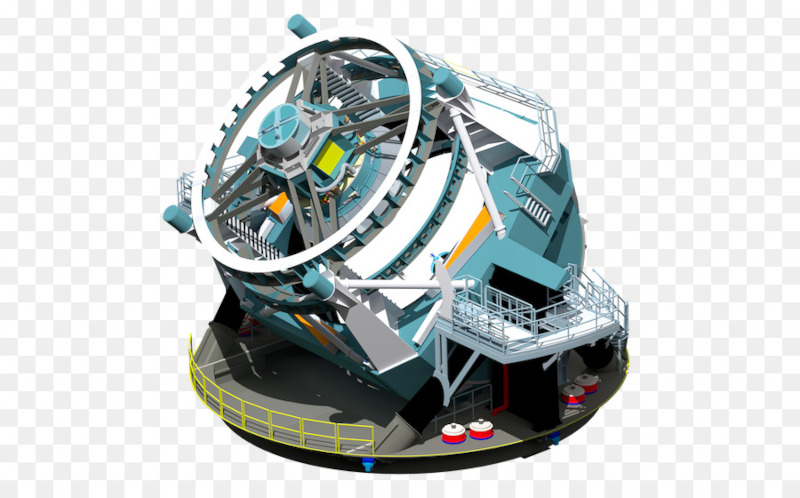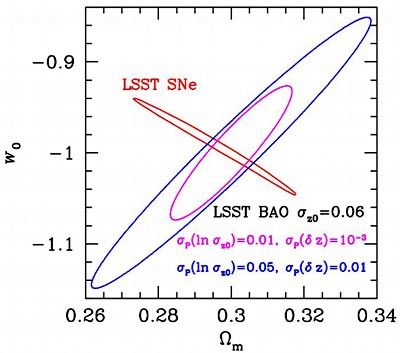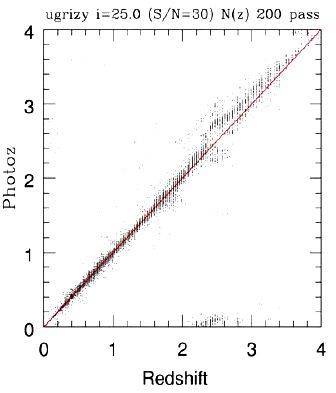The Vera C. Rubin Observatory, previously referred to as the Large Synoptic Survey Telescope LSST is a telescope in Chile aiming at a extensive survey of the southern sky (20 000 square degrees) in 6 photometric bands (visible). One of the main of objectives is to obtain, from these observations, constraints on the properties of the dark energy improving on previous surveys such as BOSS.

The Vera C. Rubin Observatory is a 8.4 m telescope. It is located in Chile, at the Cerro Pachón, which already houses the Gemini Sud telescope. The camera has a 200 CCD 4k x 4k mosaic, totaling 3.2 billion pixels, giving it a field of view of ten square degrees.
At a rate of one pose every fifteen seconds, the LSST survey will cover the entire visible sky of Chile in six wavelengths of the visible (u, g, r, I, z and Y). At the end of the program planned over 10 years, each field will have been imaged several hundred times, reaching a sensitivity R = 27.8AB mag.
Frequent returns to the same place in the sky make it possible to be sensitive to transient phenomena such as supernovae and asteroids (including those that could threaten the Earth). The depth of the reading obtained by summing all the exposures allows the study of the effects of gravitational lenses, oscillations of baryons, the structure of the Milky Way, etc. The volume of data produced is analogous to that of the LHC (15-30 TB per day). Among other things, it is planned to build a catalog of 3 billion galaxies and to observe 2 million of la-type supernovae.
The considerable advantage of the LSST is that it brings together a very large mirror and a very large field camera, giving it an unmatched extent (the extent is the product of the surface of the mirror by the covered field, and it plays the same role for A survey telescope as the luminosity for a particle accelerator).
Construction has begun in 2014, the first light is expected in 2024.
The LSST will allow for a wide range of scientific research going from the search for small objects in the solar system to the precision astrometry of the outer regions of the Galaxy and to the systematic monitoring of transient effects In the optical sky. Ten scientific panels have been set up for this purpose:
- study of gravitational shear (shear et weak lensing)
- gravitational lenses
- measuring distances using supernovae
- baryon acoustic oscillations (BAO pour Baryon Acoustic Oscillations)
- galaxies
- active nuclei of galaxies
- structure of the Milky Way
- stellar populations
- variable stars and transient phenomena
- solar system
The figure below shows the expected results on the values of the cosmological parameters w and Ωm: the interest of crossing several methods is obvious.

The consortium includes several CNRS-IN2P3 laboratories (APC, CCIN2P3, IJClab, LMA, LPNHE, LPSC, CPPM, LPC, LUPM). In close collaboration with SLAC, the IN2P3 teams focus mainly on the construction of the camera. It is the image of the project: 1.90 long, with a focal plane 64 cm in diameter, for a total cost of about 100 million dollars.
APC is particularly interested in the study of the distribution and evolution of galaxy clusters, the acoustic oscillations of the baryons and the effects of gravitational lenses. The LSST is indeed admirably well placed to study the nature of dark energy. The measurement of the acoustic oscillations of the baryons is well tested with redshifts measured spectroscopically, but the LSST proposes to measure them photometrically ("Photo-z") as often as possible. The accuracy of these photometric measurements is therefore a critical point of the program.

Several LSST scientific programs require that the luminosity measurements made by the telescope be calibrated to the nearest percent. In order to regularly achieve such accuracy, the APC performs a modeling of the effects of the atmosphere, which requires extremely careful and meticulous work, in particular the modeling of all the absorption lines of the atmosphere.
The figure shows a comparison between the accuracy of the measurement of red shifts by the spectroscopic method and the proposed photometric method.
APC is also exploring the feasibility of using calibration data from an auxiliary 1m diameter telescope constructed adjacent to the LSST.
The APC also supported a part of the camera control and control via the definition of the communication bus architecture between the control system submodules, which will be implemented in Java. The laboratory will also carry out the implementation of one of these submodules, one that drives the filter changer, a huge carousel that must regularly place a new filter in front of the focal plane. The mechanical realization of this carrousel is partly the responsibility of the LPNHE. Until a mechanical prototype exists, we will also develop a software simulator of the filter changer.
There are six permanent researchers and professors in the APC LSST group: three permanent engineers, one postdoc, one non-permanent engineer, and one student. Our largest technical contributions to LSST are focused on the construction of its camera: the architecture and development of the camera control and command systems and development of the filter-change sub-system. We also do scientific coordination for the French camera construction. Principal scientific themes are galaxy clusters, joint analyses and cross-correlations between different probes, and gravitational lensing.
List of APC staff involved
Liens
- LSST website: http://www.lsst.org/lsst
- LSST in France: http://lsst.in2p3.fr
- For more information: numbers 16 and 17 of the Lettre Informatique de l'IN2P3.
